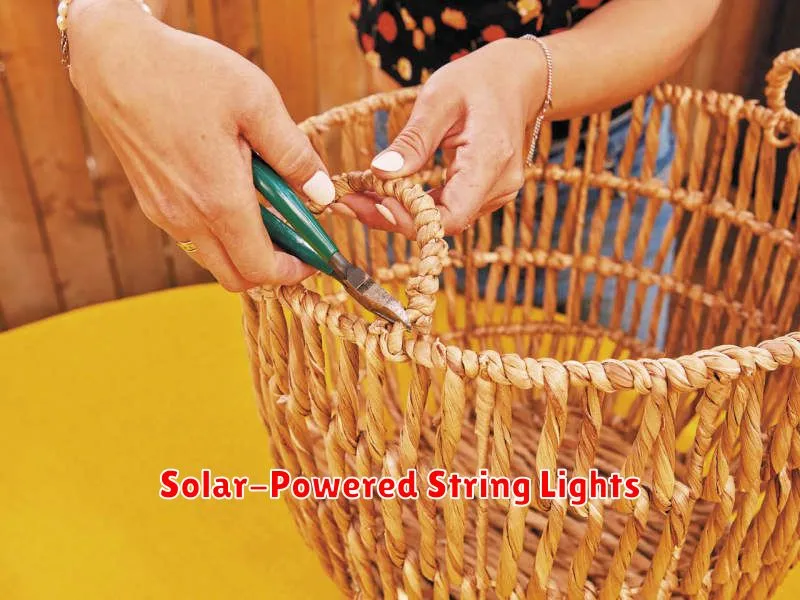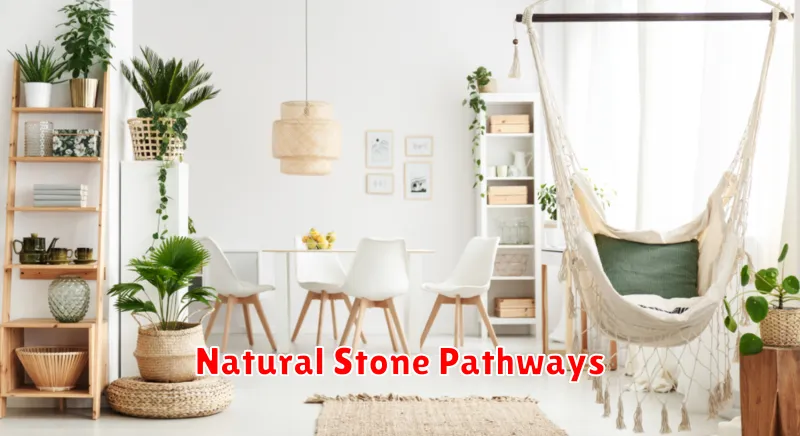Creating a beautiful and inviting outdoor space doesn’t have to come at the cost of the environment. This article explores eco-friendly outdoor decor tips, guiding you towards sustainable choices for your patio, garden, or deck. Learn how to incorporate recycled materials, sustainable landscaping, and energy-efficient lighting to enhance your outdoor area while minimizing your environmental impact. Discover practical and stylish ways to achieve a stunning, eco-conscious outdoor design that reflects your commitment to a greener lifestyle. We’ll delve into specific ideas, including upcycled furniture, native plants, and water-wise gardening techniques, empowering you to create an outdoor oasis that’s both beautiful and environmentally responsible.
Solar-Powered String Lights

Enhance your outdoor space with eco-friendly illumination using solar-powered string lights. These lights offer a sustainable alternative to traditional electric string lights, reducing your carbon footprint and energy consumption. Their versatility allows for creative placement, whether adorning patios, gardens, or pathways.
The convenience of solar-powered string lights is undeniable. Requiring no external power source, installation is simple and requires minimal effort. During the day, the solar panels efficiently charge the batteries, ensuring hours of ambient lighting at night. This makes them ideal for various outdoor settings with limited access to electricity.
Consider the durability and features when selecting solar-powered string lights. Look for options with weather-resistant materials to ensure longevity and reliable performance in various weather conditions. Many models offer adjustable brightness settings and different lighting modes for personalized ambiance.
Recycled Wooden Benches

Recycled wooden benches offer a sustainable and stylish addition to any outdoor space. By repurposing reclaimed wood, you reduce waste and minimize the environmental impact associated with new lumber production. This eco-conscious choice contributes to a greener lifestyle while providing durable and aesthetically pleasing seating.
The unique character of recycled wood adds visual interest to your garden or patio. Variations in color and texture create a rustic charm, often enhancing the natural beauty of the surrounding environment. Moreover, the strength and resilience of well-maintained reclaimed wood ensures your bench will withstand the elements for years to come.
When selecting a recycled wooden bench, consider factors such as the type of wood, the construction quality, and the overall style to ensure it complements your existing outdoor décor. Proper treatment and maintenance, such as applying a weather-resistant sealant, will further prolong its lifespan and preserve its natural beauty.
Upcycled Planters

Give your outdoor space an eco-friendly makeover with upcycled planters. Transforming old, discarded items into beautiful containers for your plants is a fantastic way to reduce waste and add unique character to your garden or patio. Consider using items like old boots, tin cans, or even broken pottery.
The process is surprisingly simple. Thoroughly clean your chosen containers, ensuring they are free from any harmful residues. For items that may leak, consider lining them with plastic sheeting before adding soil. Adding a layer of gravel to the base improves drainage. Creativity is key; paint your planters, add decorative elements, or leave them with a rustic charm.
Upcycled planters not only offer a sustainable alternative to mass-produced options, but they also provide an opportunity for personalized expression. By repurposing everyday objects, you can create truly unique and visually appealing features for your outdoor environment. The result is a beautiful and environmentally conscious garden.
Rain Barrel Water Features

Rain barrels offer a stylish and sustainable way to enhance your outdoor decor. By collecting rainwater, these barrels provide a readily available source of water for irrigation, reducing reliance on municipal water supplies. Their rustic charm adds a touch of natural elegance to any landscape, blending seamlessly with various design aesthetics.
Beyond their practical function, rain barrel water features can be creatively incorporated into your garden design. Overflow pipes can be strategically positioned to create miniature waterfalls or cascading streams, adding a soothing soundscape to your outdoor space. The barrels themselves can be painted or decorated to complement existing themes, further enhancing their aesthetic appeal.
Consider the size and placement of your rain barrel carefully. Larger barrels offer greater water storage capacity, while smaller barrels may be more aesthetically pleasing in tighter spaces. Placement should be strategic to maximize rainwater collection while ensuring safe and easy access for maintenance and water harvesting.
Natural Stone Pathways

Creating a pathway using natural stone offers a multitude of eco-friendly benefits. Locally sourced stones minimize transportation emissions, reducing your carbon footprint. Furthermore, natural stone is a durable and long-lasting material, requiring less frequent replacement compared to other paving options, thus decreasing waste.
The aesthetic appeal of natural stone pathways adds to their eco-friendly appeal. They blend seamlessly with the surrounding landscape, creating a harmonious and natural look. This minimizes the need for excessive landscaping or artificial elements, contributing to a more sustainable outdoor space.
Consider the porosity of the stone when choosing your material. While some stones may require sealing to prevent staining, selecting a naturally weather-resistant option can further minimize maintenance and environmental impact. Proper installation is also crucial for longevity and minimal environmental disruption.
Handwoven Outdoor Rugs

Handwoven outdoor rugs offer a sustainable and stylish addition to your eco-friendly outdoor décor. Made from natural materials like jute, sisal, or seagrass, these rugs are biodegradable and often sourced from renewable resources, minimizing their environmental impact compared to synthetic alternatives.
Their durability is another key advantage. Unlike many synthetic rugs, handwoven options are designed to withstand the elements, requiring less frequent replacement and reducing waste. Furthermore, the unique textures and patterns add a touch of natural beauty to any outdoor space.
When choosing a handwoven rug, consider its material composition and dyeing process. Opt for rugs made with natural, undyed fibers whenever possible, or those dyed with eco-friendly, non-toxic dyes to further reduce your environmental footprint. Proper cleaning and maintenance will extend their lifespan, maximizing their sustainable benefits.
Recycled Metal Sculptures

Incorporating recycled metal sculptures into your outdoor decor offers a unique and sustainable approach to enhancing your landscape. These sculptures, often crafted from reclaimed materials such as scrap metal, discarded machinery parts, or even old vehicles, provide a striking visual element while promoting environmental consciousness. The inherent textures and patina of the metal add character and a sense of rustic charm.
The durability of metal ensures these sculptures can withstand the elements, providing long-lasting beauty without the need for frequent replacements. Their versatility allows for diverse styles, from abstract and modern designs to more whimsical and representational pieces. Furthermore, supporting artists who utilize recycled materials directly contributes to a circular economy, reducing waste and promoting responsible resource management.
Consider the size and scale of the sculpture in relation to your outdoor space. Placement is crucial; a strategically positioned piece can become a focal point, drawing the eye and adding visual interest. Think about the surrounding landscape and choose a sculpture that complements the existing aesthetic. The integration of recycled metal sculptures provides both aesthetic appeal and a powerful statement about your commitment to eco-friendly practices.
Sustainable Bamboo Furniture

Bamboo is a rapidly renewable resource, making it an excellent choice for sustainable outdoor furniture. Unlike hardwoods that require decades to mature, bamboo can be harvested in as little as three to five years, significantly reducing its environmental impact. This rapid growth cycle contributes to its eco-friendly status and makes it a responsible alternative to traditional materials.
Bamboo furniture offers several advantages beyond sustainability. Its strength and durability ensure long-lasting outdoor pieces capable of withstanding various weather conditions. Furthermore, its inherent aesthetic qualities lend themselves well to a variety of design styles, seamlessly integrating into various outdoor settings. Many pieces are naturally water-resistant, reducing the need for extensive treatments.
When selecting bamboo furniture, prioritize pieces made from sustainably harvested bamboo and finished with eco-friendly paints or stains. Look for certifications from reputable organizations to ensure responsible sourcing and manufacturing processes. By choosing sustainable bamboo furniture, you contribute to environmental conservation while enhancing your outdoor space with durable and stylish pieces.
Compost Bin Decor

Transforming a compost bin from a utilitarian item into an attractive outdoor feature is achievable with a few simple techniques. Consider camouflaging the bin by placing it behind taller plants or shrubs, effectively integrating it into the garden’s landscape. Alternatively, you can enhance its appearance with a coat of weather-resistant paint in a color that complements your home’s exterior or garden theme.
For a more decorative approach, consider constructing a compost bin enclosure using natural materials like reclaimed wood or bamboo. This creates a visually appealing structure that hides the bin while adding a rustic or modern charm to your outdoor space, depending on the chosen materials and design. Placement is key; strategically locating the bin near a fence or wall can minimize its visual impact.
Adding decorative elements such as vines or climbing plants to grow over or around the bin can further enhance its aesthetic appeal. These plants not only conceal the bin but also add a vibrant, natural touch to your outdoor décor. Remember that regular maintenance is crucial to keeping both the compost bin and its surroundings looking neat and tidy.
Vertical Herb Gardens

Vertical herb gardens offer a space-saving and aesthetically pleasing way to incorporate fresh herbs into your outdoor décor. These gardens can be constructed from a variety of recycled materials, such as pallets, repurposed containers, or even old window frames, promoting an eco-friendly approach to landscaping. The vertical design maximizes growing space, particularly beneficial for smaller yards or patios.
Planting herbs vertically allows for optimal sunlight exposure for each plant, resulting in healthier and more bountiful harvests. The structure itself can become a focal point in your outdoor space, adding a touch of rustic charm or modern elegance depending on the materials and design chosen. Consider using a variety of herbs with different heights and textures for visual interest.
Beyond the aesthetic benefits, a vertical herb garden contributes to a sustainable lifestyle. By growing your own herbs, you reduce your carbon footprint associated with transportation and packaging of commercially grown herbs. Furthermore, it fosters a connection with nature and encourages mindful gardening practices, adding to the overall eco-friendly appeal of your outdoor space.

